NURS1008 Indigenous Health: Deconstructing Aboriginal Substance Abuse
VerifiedAdded on 2023/06/14
|8
|2162
|289
Essay
AI Summary
This essay deconstructs the question "Why are Aboriginal people prone to alcohol and substance abuse?" by examining the underlying assumptions, stereotypes, and hidden messages within the question itself. It delves into the historical context of colonization, land loss, and socio-economic exclusion experienced by Aboriginal and Torres Strait Islander people, arguing that these factors contribute significantly to substance abuse issues. The essay critiques the question's inherent biases and calls for a more compassionate and understanding approach, emphasizing the need to address societal factors and discrimination rather than perpetuating stereotypes. It concludes that the question prompts a broader exploration of the challenges faced by Aboriginal communities and the importance of further research to uncover the root causes of their struggles.
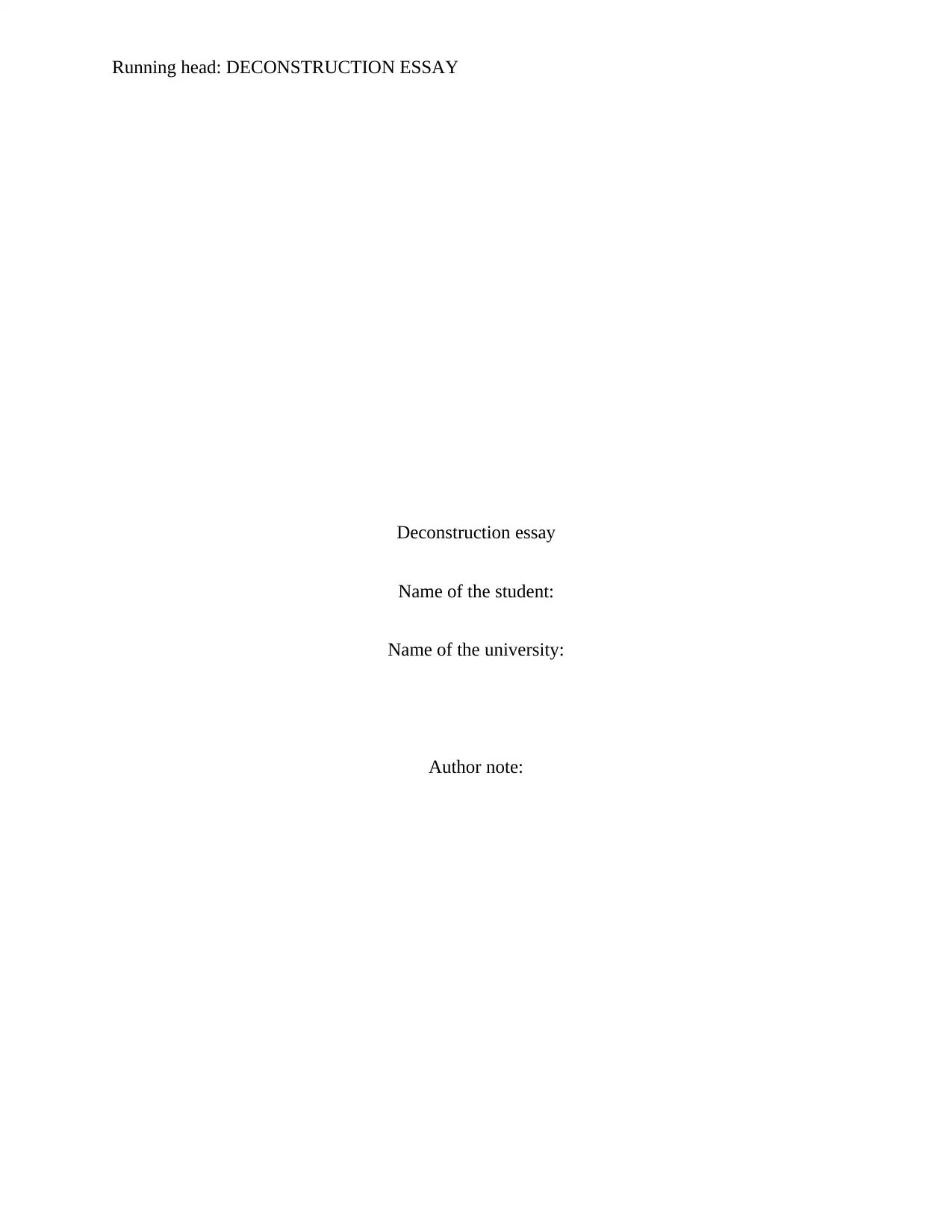
Running head: DECONSTRUCTION ESSAY
Deconstruction essay
Name of the student:
Name of the university:
Author note:
Deconstruction essay
Name of the student:
Name of the university:
Author note:
Paraphrase This Document
Need a fresh take? Get an instant paraphrase of this document with our AI Paraphraser
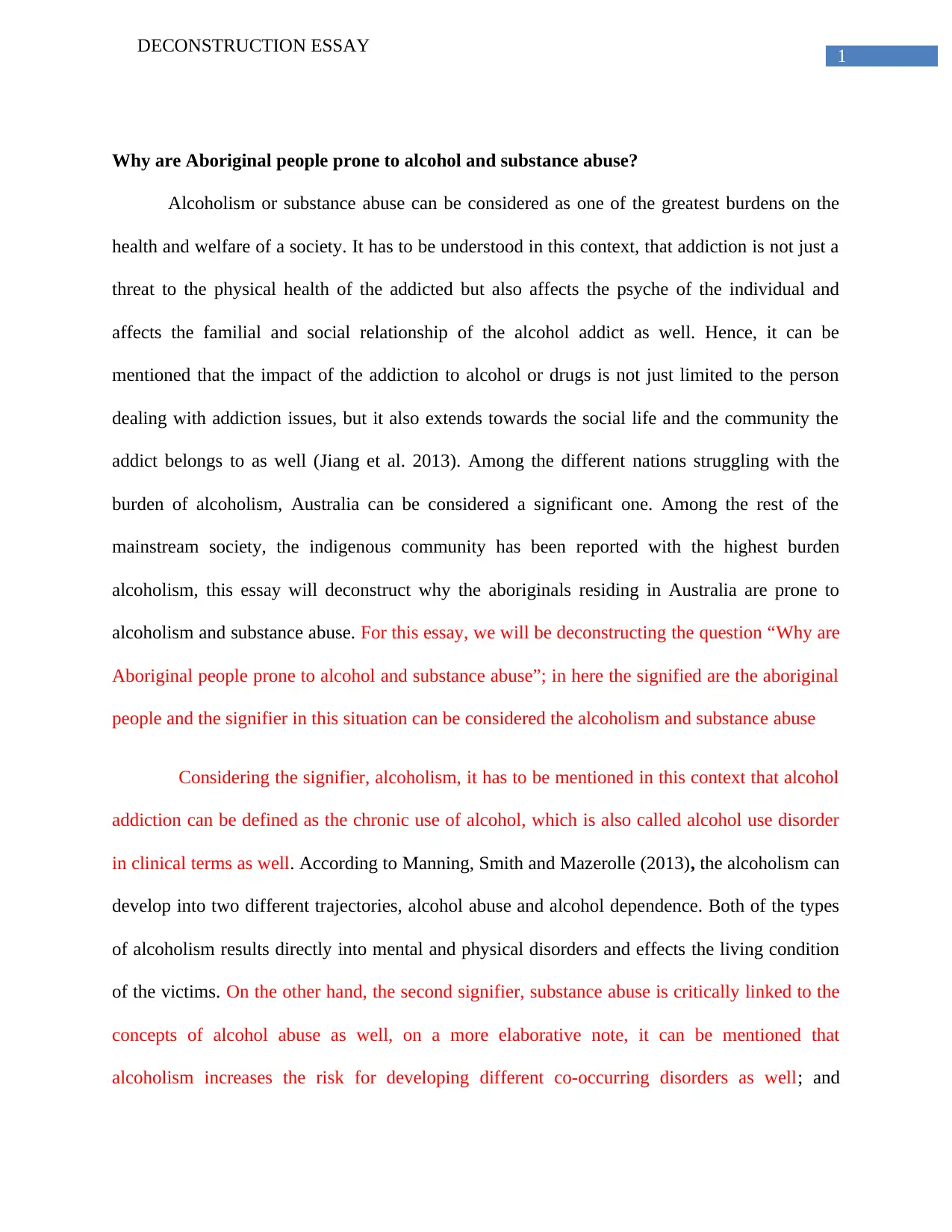
1
DECONSTRUCTION ESSAY
Why are Aboriginal people prone to alcohol and substance abuse?
Alcoholism or substance abuse can be considered as one of the greatest burdens on the
health and welfare of a society. It has to be understood in this context, that addiction is not just a
threat to the physical health of the addicted but also affects the psyche of the individual and
affects the familial and social relationship of the alcohol addict as well. Hence, it can be
mentioned that the impact of the addiction to alcohol or drugs is not just limited to the person
dealing with addiction issues, but it also extends towards the social life and the community the
addict belongs to as well (Jiang et al. 2013). Among the different nations struggling with the
burden of alcoholism, Australia can be considered a significant one. Among the rest of the
mainstream society, the indigenous community has been reported with the highest burden
alcoholism, this essay will deconstruct why the aboriginals residing in Australia are prone to
alcoholism and substance abuse. For this essay, we will be deconstructing the question “Why are
Aboriginal people prone to alcohol and substance abuse”; in here the signified are the aboriginal
people and the signifier in this situation can be considered the alcoholism and substance abuse
Considering the signifier, alcoholism, it has to be mentioned in this context that alcohol
addiction can be defined as the chronic use of alcohol, which is also called alcohol use disorder
in clinical terms as well. According to Manning, Smith and Mazerolle (2013), the alcoholism can
develop into two different trajectories, alcohol abuse and alcohol dependence. Both of the types
of alcoholism results directly into mental and physical disorders and effects the living condition
of the victims. On the other hand, the second signifier, substance abuse is critically linked to the
concepts of alcohol abuse as well, on a more elaborative note, it can be mentioned that
alcoholism increases the risk for developing different co-occurring disorders as well; and
DECONSTRUCTION ESSAY
Why are Aboriginal people prone to alcohol and substance abuse?
Alcoholism or substance abuse can be considered as one of the greatest burdens on the
health and welfare of a society. It has to be understood in this context, that addiction is not just a
threat to the physical health of the addicted but also affects the psyche of the individual and
affects the familial and social relationship of the alcohol addict as well. Hence, it can be
mentioned that the impact of the addiction to alcohol or drugs is not just limited to the person
dealing with addiction issues, but it also extends towards the social life and the community the
addict belongs to as well (Jiang et al. 2013). Among the different nations struggling with the
burden of alcoholism, Australia can be considered a significant one. Among the rest of the
mainstream society, the indigenous community has been reported with the highest burden
alcoholism, this essay will deconstruct why the aboriginals residing in Australia are prone to
alcoholism and substance abuse. For this essay, we will be deconstructing the question “Why are
Aboriginal people prone to alcohol and substance abuse”; in here the signified are the aboriginal
people and the signifier in this situation can be considered the alcoholism and substance abuse
Considering the signifier, alcoholism, it has to be mentioned in this context that alcohol
addiction can be defined as the chronic use of alcohol, which is also called alcohol use disorder
in clinical terms as well. According to Manning, Smith and Mazerolle (2013), the alcoholism can
develop into two different trajectories, alcohol abuse and alcohol dependence. Both of the types
of alcoholism results directly into mental and physical disorders and effects the living condition
of the victims. On the other hand, the second signifier, substance abuse is critically linked to the
concepts of alcohol abuse as well, on a more elaborative note, it can be mentioned that
alcoholism increases the risk for developing different co-occurring disorders as well; and
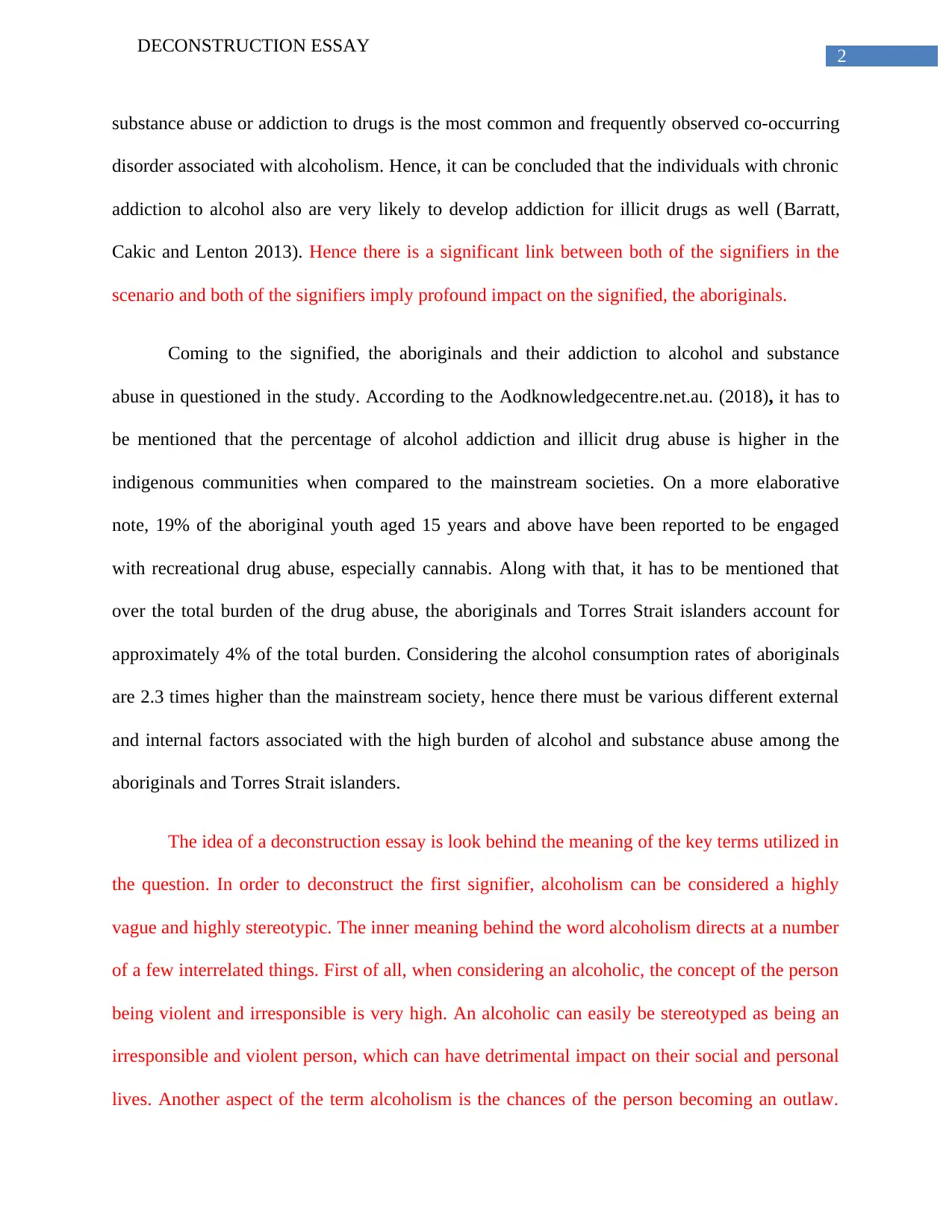
2
DECONSTRUCTION ESSAY
substance abuse or addiction to drugs is the most common and frequently observed co-occurring
disorder associated with alcoholism. Hence, it can be concluded that the individuals with chronic
addiction to alcohol also are very likely to develop addiction for illicit drugs as well (Barratt,
Cakic and Lenton 2013). Hence there is a significant link between both of the signifiers in the
scenario and both of the signifiers imply profound impact on the signified, the aboriginals.
Coming to the signified, the aboriginals and their addiction to alcohol and substance
abuse in questioned in the study. According to the Aodknowledgecentre.net.au. (2018), it has to
be mentioned that the percentage of alcohol addiction and illicit drug abuse is higher in the
indigenous communities when compared to the mainstream societies. On a more elaborative
note, 19% of the aboriginal youth aged 15 years and above have been reported to be engaged
with recreational drug abuse, especially cannabis. Along with that, it has to be mentioned that
over the total burden of the drug abuse, the aboriginals and Torres Strait islanders account for
approximately 4% of the total burden. Considering the alcohol consumption rates of aboriginals
are 2.3 times higher than the mainstream society, hence there must be various different external
and internal factors associated with the high burden of alcohol and substance abuse among the
aboriginals and Torres Strait islanders.
The idea of a deconstruction essay is look behind the meaning of the key terms utilized in
the question. In order to deconstruct the first signifier, alcoholism can be considered a highly
vague and highly stereotypic. The inner meaning behind the word alcoholism directs at a number
of a few interrelated things. First of all, when considering an alcoholic, the concept of the person
being violent and irresponsible is very high. An alcoholic can easily be stereotyped as being an
irresponsible and violent person, which can have detrimental impact on their social and personal
lives. Another aspect of the term alcoholism is the chances of the person becoming an outlaw.
DECONSTRUCTION ESSAY
substance abuse or addiction to drugs is the most common and frequently observed co-occurring
disorder associated with alcoholism. Hence, it can be concluded that the individuals with chronic
addiction to alcohol also are very likely to develop addiction for illicit drugs as well (Barratt,
Cakic and Lenton 2013). Hence there is a significant link between both of the signifiers in the
scenario and both of the signifiers imply profound impact on the signified, the aboriginals.
Coming to the signified, the aboriginals and their addiction to alcohol and substance
abuse in questioned in the study. According to the Aodknowledgecentre.net.au. (2018), it has to
be mentioned that the percentage of alcohol addiction and illicit drug abuse is higher in the
indigenous communities when compared to the mainstream societies. On a more elaborative
note, 19% of the aboriginal youth aged 15 years and above have been reported to be engaged
with recreational drug abuse, especially cannabis. Along with that, it has to be mentioned that
over the total burden of the drug abuse, the aboriginals and Torres Strait islanders account for
approximately 4% of the total burden. Considering the alcohol consumption rates of aboriginals
are 2.3 times higher than the mainstream society, hence there must be various different external
and internal factors associated with the high burden of alcohol and substance abuse among the
aboriginals and Torres Strait islanders.
The idea of a deconstruction essay is look behind the meaning of the key terms utilized in
the question. In order to deconstruct the first signifier, alcoholism can be considered a highly
vague and highly stereotypic. The inner meaning behind the word alcoholism directs at a number
of a few interrelated things. First of all, when considering an alcoholic, the concept of the person
being violent and irresponsible is very high. An alcoholic can easily be stereotyped as being an
irresponsible and violent person, which can have detrimental impact on their social and personal
lives. Another aspect of the term alcoholism is the chances of the person becoming an outlaw.
⊘ This is a preview!⊘
Do you want full access?
Subscribe today to unlock all pages.

Trusted by 1+ million students worldwide
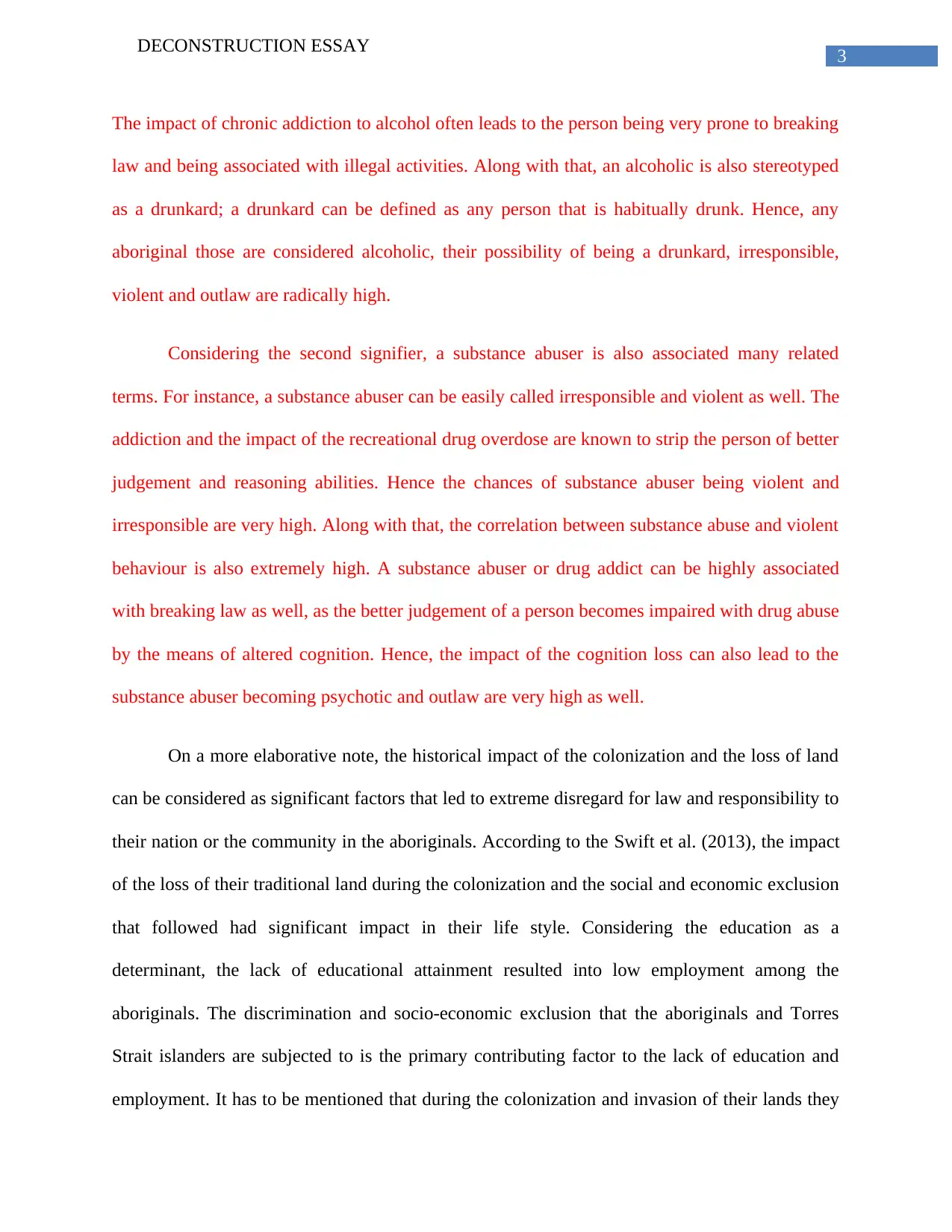
3
DECONSTRUCTION ESSAY
The impact of chronic addiction to alcohol often leads to the person being very prone to breaking
law and being associated with illegal activities. Along with that, an alcoholic is also stereotyped
as a drunkard; a drunkard can be defined as any person that is habitually drunk. Hence, any
aboriginal those are considered alcoholic, their possibility of being a drunkard, irresponsible,
violent and outlaw are radically high.
Considering the second signifier, a substance abuser is also associated many related
terms. For instance, a substance abuser can be easily called irresponsible and violent as well. The
addiction and the impact of the recreational drug overdose are known to strip the person of better
judgement and reasoning abilities. Hence the chances of substance abuser being violent and
irresponsible are very high. Along with that, the correlation between substance abuse and violent
behaviour is also extremely high. A substance abuser or drug addict can be highly associated
with breaking law as well, as the better judgement of a person becomes impaired with drug abuse
by the means of altered cognition. Hence, the impact of the cognition loss can also lead to the
substance abuser becoming psychotic and outlaw are very high as well.
On a more elaborative note, the historical impact of the colonization and the loss of land
can be considered as significant factors that led to extreme disregard for law and responsibility to
their nation or the community in the aboriginals. According to the Swift et al. (2013), the impact
of the loss of their traditional land during the colonization and the social and economic exclusion
that followed had significant impact in their life style. Considering the education as a
determinant, the lack of educational attainment resulted into low employment among the
aboriginals. The discrimination and socio-economic exclusion that the aboriginals and Torres
Strait islanders are subjected to is the primary contributing factor to the lack of education and
employment. It has to be mentioned that during the colonization and invasion of their lands they
DECONSTRUCTION ESSAY
The impact of chronic addiction to alcohol often leads to the person being very prone to breaking
law and being associated with illegal activities. Along with that, an alcoholic is also stereotyped
as a drunkard; a drunkard can be defined as any person that is habitually drunk. Hence, any
aboriginal those are considered alcoholic, their possibility of being a drunkard, irresponsible,
violent and outlaw are radically high.
Considering the second signifier, a substance abuser is also associated many related
terms. For instance, a substance abuser can be easily called irresponsible and violent as well. The
addiction and the impact of the recreational drug overdose are known to strip the person of better
judgement and reasoning abilities. Hence the chances of substance abuser being violent and
irresponsible are very high. Along with that, the correlation between substance abuse and violent
behaviour is also extremely high. A substance abuser or drug addict can be highly associated
with breaking law as well, as the better judgement of a person becomes impaired with drug abuse
by the means of altered cognition. Hence, the impact of the cognition loss can also lead to the
substance abuser becoming psychotic and outlaw are very high as well.
On a more elaborative note, the historical impact of the colonization and the loss of land
can be considered as significant factors that led to extreme disregard for law and responsibility to
their nation or the community in the aboriginals. According to the Swift et al. (2013), the impact
of the loss of their traditional land during the colonization and the social and economic exclusion
that followed had significant impact in their life style. Considering the education as a
determinant, the lack of educational attainment resulted into low employment among the
aboriginals. The discrimination and socio-economic exclusion that the aboriginals and Torres
Strait islanders are subjected to is the primary contributing factor to the lack of education and
employment. It has to be mentioned that during the colonization and invasion of their lands they
Paraphrase This Document
Need a fresh take? Get an instant paraphrase of this document with our AI Paraphraser
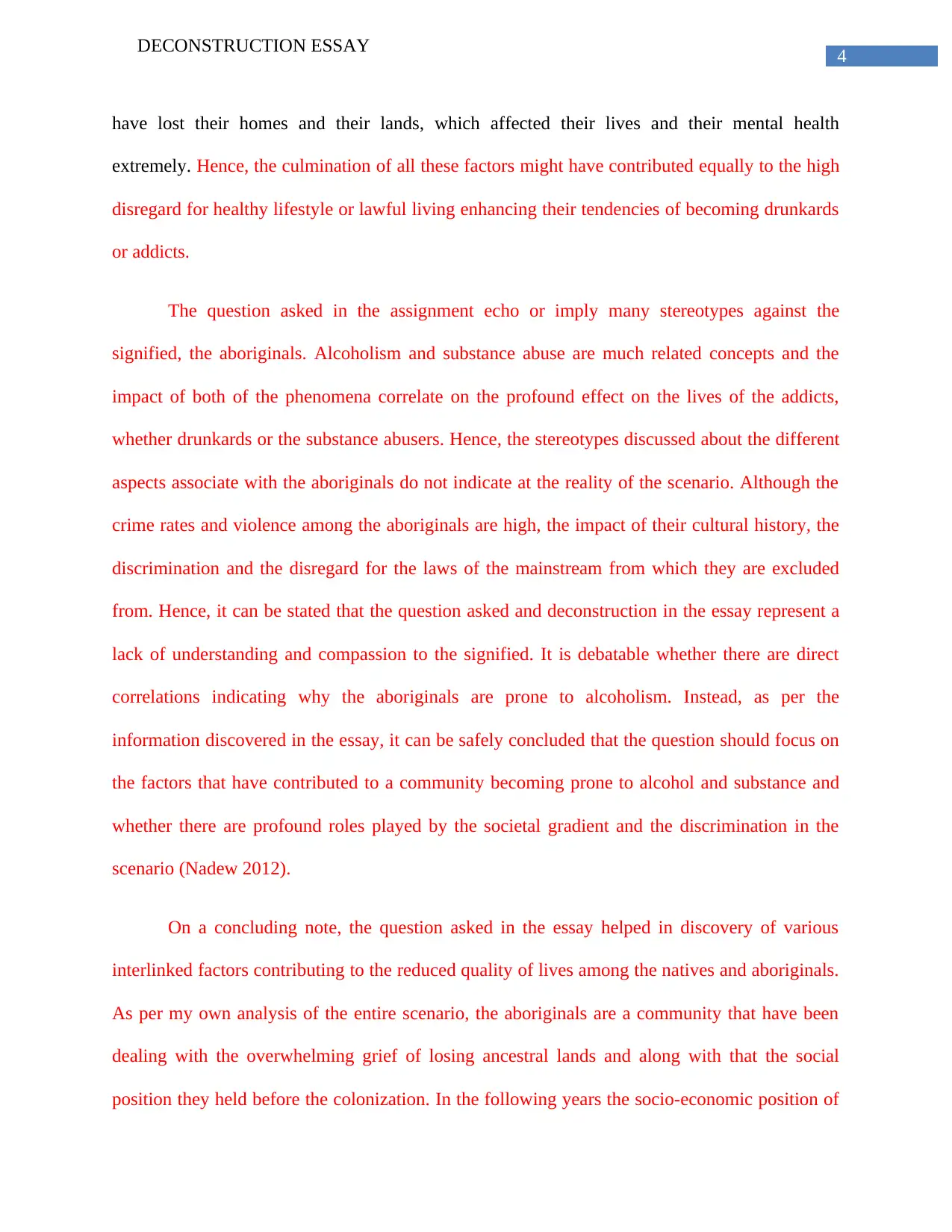
4
DECONSTRUCTION ESSAY
have lost their homes and their lands, which affected their lives and their mental health
extremely. Hence, the culmination of all these factors might have contributed equally to the high
disregard for healthy lifestyle or lawful living enhancing their tendencies of becoming drunkards
or addicts.
The question asked in the assignment echo or imply many stereotypes against the
signified, the aboriginals. Alcoholism and substance abuse are much related concepts and the
impact of both of the phenomena correlate on the profound effect on the lives of the addicts,
whether drunkards or the substance abusers. Hence, the stereotypes discussed about the different
aspects associate with the aboriginals do not indicate at the reality of the scenario. Although the
crime rates and violence among the aboriginals are high, the impact of their cultural history, the
discrimination and the disregard for the laws of the mainstream from which they are excluded
from. Hence, it can be stated that the question asked and deconstruction in the essay represent a
lack of understanding and compassion to the signified. It is debatable whether there are direct
correlations indicating why the aboriginals are prone to alcoholism. Instead, as per the
information discovered in the essay, it can be safely concluded that the question should focus on
the factors that have contributed to a community becoming prone to alcohol and substance and
whether there are profound roles played by the societal gradient and the discrimination in the
scenario (Nadew 2012).
On a concluding note, the question asked in the essay helped in discovery of various
interlinked factors contributing to the reduced quality of lives among the natives and aboriginals.
As per my own analysis of the entire scenario, the aboriginals are a community that have been
dealing with the overwhelming grief of losing ancestral lands and along with that the social
position they held before the colonization. In the following years the socio-economic position of
DECONSTRUCTION ESSAY
have lost their homes and their lands, which affected their lives and their mental health
extremely. Hence, the culmination of all these factors might have contributed equally to the high
disregard for healthy lifestyle or lawful living enhancing their tendencies of becoming drunkards
or addicts.
The question asked in the assignment echo or imply many stereotypes against the
signified, the aboriginals. Alcoholism and substance abuse are much related concepts and the
impact of both of the phenomena correlate on the profound effect on the lives of the addicts,
whether drunkards or the substance abusers. Hence, the stereotypes discussed about the different
aspects associate with the aboriginals do not indicate at the reality of the scenario. Although the
crime rates and violence among the aboriginals are high, the impact of their cultural history, the
discrimination and the disregard for the laws of the mainstream from which they are excluded
from. Hence, it can be stated that the question asked and deconstruction in the essay represent a
lack of understanding and compassion to the signified. It is debatable whether there are direct
correlations indicating why the aboriginals are prone to alcoholism. Instead, as per the
information discovered in the essay, it can be safely concluded that the question should focus on
the factors that have contributed to a community becoming prone to alcohol and substance and
whether there are profound roles played by the societal gradient and the discrimination in the
scenario (Nadew 2012).
On a concluding note, the question asked in the essay helped in discovery of various
interlinked factors contributing to the reduced quality of lives among the natives and aboriginals.
As per my own analysis of the entire scenario, the aboriginals are a community that have been
dealing with the overwhelming grief of losing ancestral lands and along with that the social
position they held before the colonization. In the following years the socio-economic position of
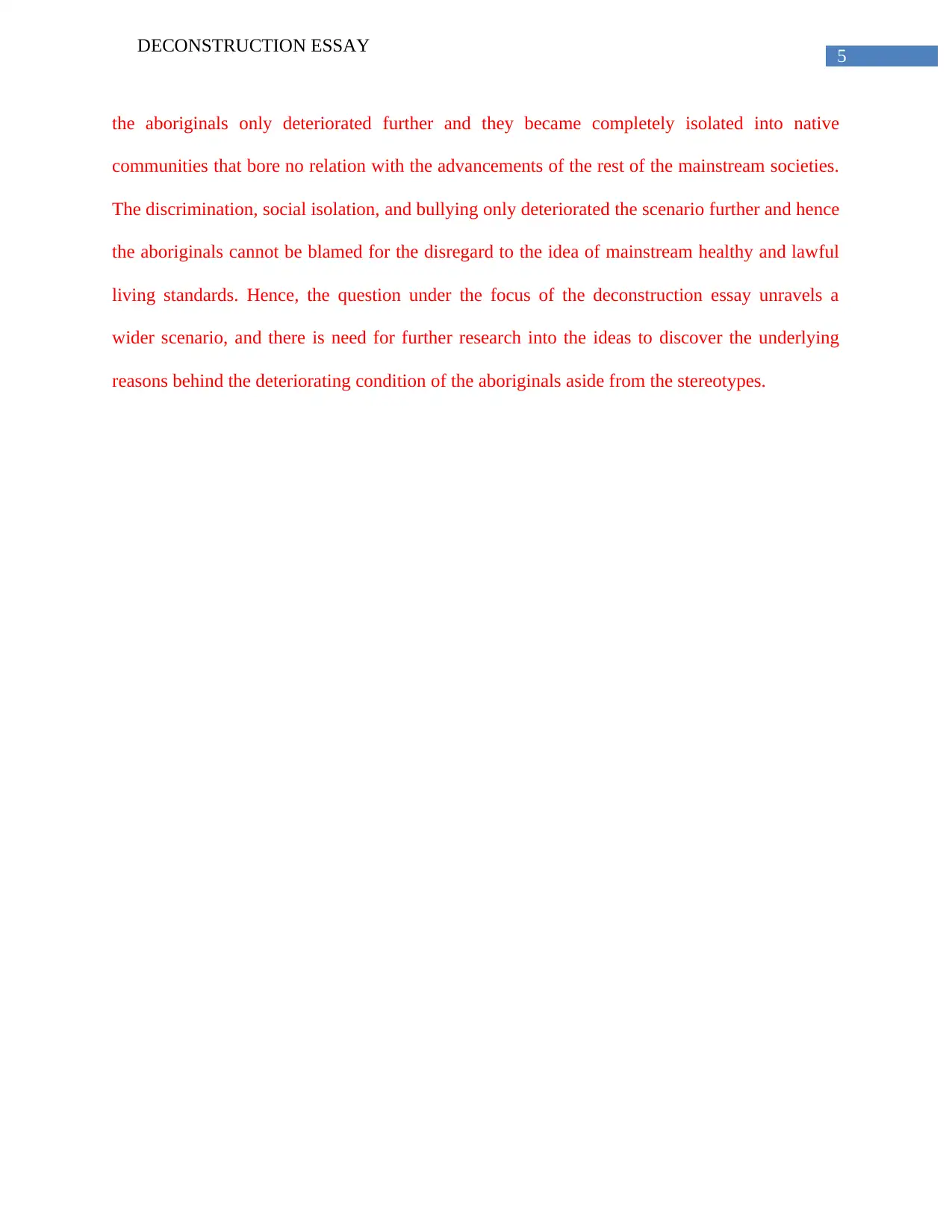
5
DECONSTRUCTION ESSAY
the aboriginals only deteriorated further and they became completely isolated into native
communities that bore no relation with the advancements of the rest of the mainstream societies.
The discrimination, social isolation, and bullying only deteriorated the scenario further and hence
the aboriginals cannot be blamed for the disregard to the idea of mainstream healthy and lawful
living standards. Hence, the question under the focus of the deconstruction essay unravels a
wider scenario, and there is need for further research into the ideas to discover the underlying
reasons behind the deteriorating condition of the aboriginals aside from the stereotypes.
DECONSTRUCTION ESSAY
the aboriginals only deteriorated further and they became completely isolated into native
communities that bore no relation with the advancements of the rest of the mainstream societies.
The discrimination, social isolation, and bullying only deteriorated the scenario further and hence
the aboriginals cannot be blamed for the disregard to the idea of mainstream healthy and lawful
living standards. Hence, the question under the focus of the deconstruction essay unravels a
wider scenario, and there is need for further research into the ideas to discover the underlying
reasons behind the deteriorating condition of the aboriginals aside from the stereotypes.
⊘ This is a preview!⊘
Do you want full access?
Subscribe today to unlock all pages.

Trusted by 1+ million students worldwide
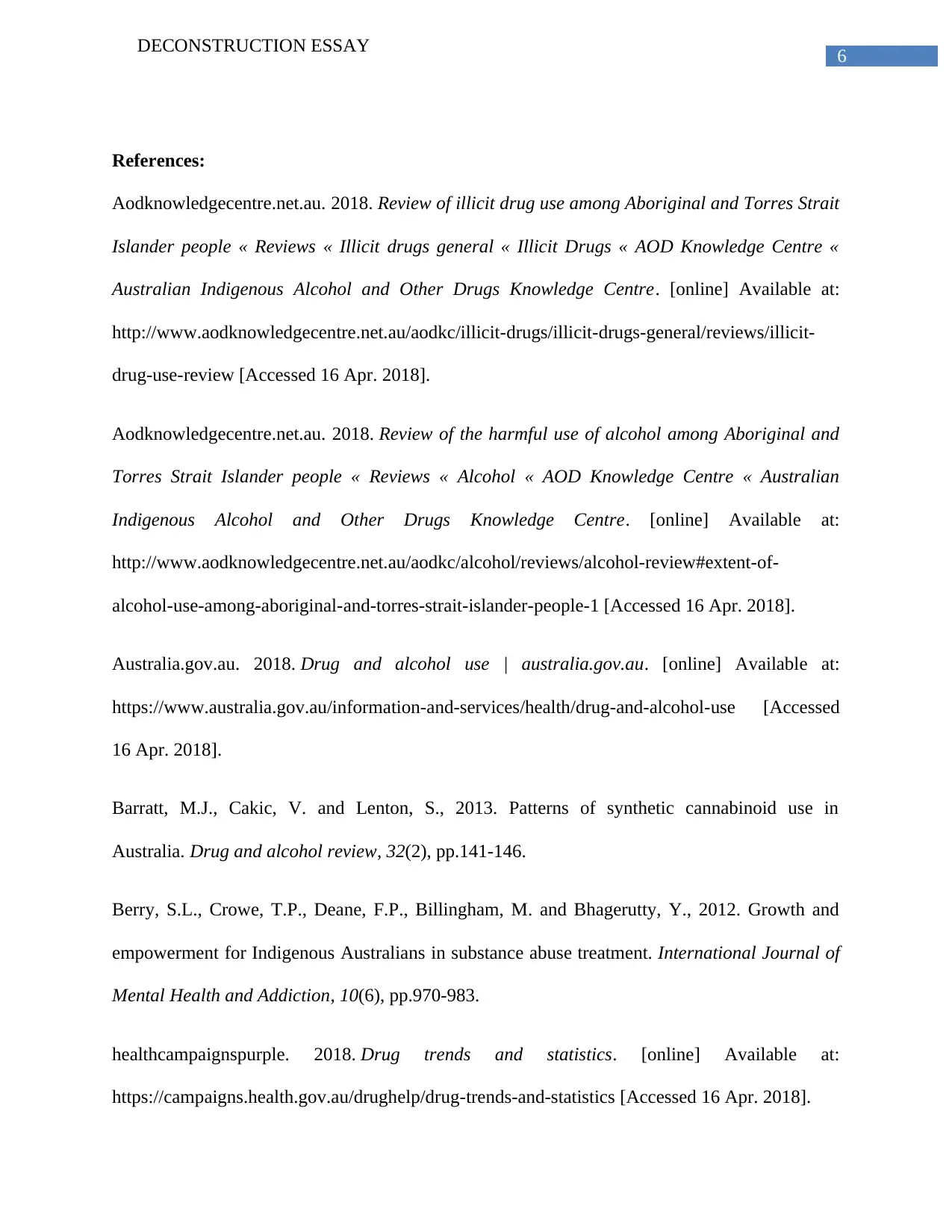
6
DECONSTRUCTION ESSAY
References:
Aodknowledgecentre.net.au. 2018. Review of illicit drug use among Aboriginal and Torres Strait
Islander people « Reviews « Illicit drugs general « Illicit Drugs « AOD Knowledge Centre «
Australian Indigenous Alcohol and Other Drugs Knowledge Centre. [online] Available at:
http://www.aodknowledgecentre.net.au/aodkc/illicit-drugs/illicit-drugs-general/reviews/illicit-
drug-use-review [Accessed 16 Apr. 2018].
Aodknowledgecentre.net.au. 2018. Review of the harmful use of alcohol among Aboriginal and
Torres Strait Islander people « Reviews « Alcohol « AOD Knowledge Centre « Australian
Indigenous Alcohol and Other Drugs Knowledge Centre. [online] Available at:
http://www.aodknowledgecentre.net.au/aodkc/alcohol/reviews/alcohol-review#extent-of-
alcohol-use-among-aboriginal-and-torres-strait-islander-people-1 [Accessed 16 Apr. 2018].
Australia.gov.au. 2018. Drug and alcohol use | australia.gov.au. [online] Available at:
https://www.australia.gov.au/information-and-services/health/drug-and-alcohol-use [Accessed
16 Apr. 2018].
Barratt, M.J., Cakic, V. and Lenton, S., 2013. Patterns of synthetic cannabinoid use in
Australia. Drug and alcohol review, 32(2), pp.141-146.
Berry, S.L., Crowe, T.P., Deane, F.P., Billingham, M. and Bhagerutty, Y., 2012. Growth and
empowerment for Indigenous Australians in substance abuse treatment. International Journal of
Mental Health and Addiction, 10(6), pp.970-983.
healthcampaignspurple. 2018. Drug trends and statistics. [online] Available at:
https://campaigns.health.gov.au/drughelp/drug-trends-and-statistics [Accessed 16 Apr. 2018].
DECONSTRUCTION ESSAY
References:
Aodknowledgecentre.net.au. 2018. Review of illicit drug use among Aboriginal and Torres Strait
Islander people « Reviews « Illicit drugs general « Illicit Drugs « AOD Knowledge Centre «
Australian Indigenous Alcohol and Other Drugs Knowledge Centre. [online] Available at:
http://www.aodknowledgecentre.net.au/aodkc/illicit-drugs/illicit-drugs-general/reviews/illicit-
drug-use-review [Accessed 16 Apr. 2018].
Aodknowledgecentre.net.au. 2018. Review of the harmful use of alcohol among Aboriginal and
Torres Strait Islander people « Reviews « Alcohol « AOD Knowledge Centre « Australian
Indigenous Alcohol and Other Drugs Knowledge Centre. [online] Available at:
http://www.aodknowledgecentre.net.au/aodkc/alcohol/reviews/alcohol-review#extent-of-
alcohol-use-among-aboriginal-and-torres-strait-islander-people-1 [Accessed 16 Apr. 2018].
Australia.gov.au. 2018. Drug and alcohol use | australia.gov.au. [online] Available at:
https://www.australia.gov.au/information-and-services/health/drug-and-alcohol-use [Accessed
16 Apr. 2018].
Barratt, M.J., Cakic, V. and Lenton, S., 2013. Patterns of synthetic cannabinoid use in
Australia. Drug and alcohol review, 32(2), pp.141-146.
Berry, S.L., Crowe, T.P., Deane, F.P., Billingham, M. and Bhagerutty, Y., 2012. Growth and
empowerment for Indigenous Australians in substance abuse treatment. International Journal of
Mental Health and Addiction, 10(6), pp.970-983.
healthcampaignspurple. 2018. Drug trends and statistics. [online] Available at:
https://campaigns.health.gov.au/drughelp/drug-trends-and-statistics [Accessed 16 Apr. 2018].
Paraphrase This Document
Need a fresh take? Get an instant paraphrase of this document with our AI Paraphraser
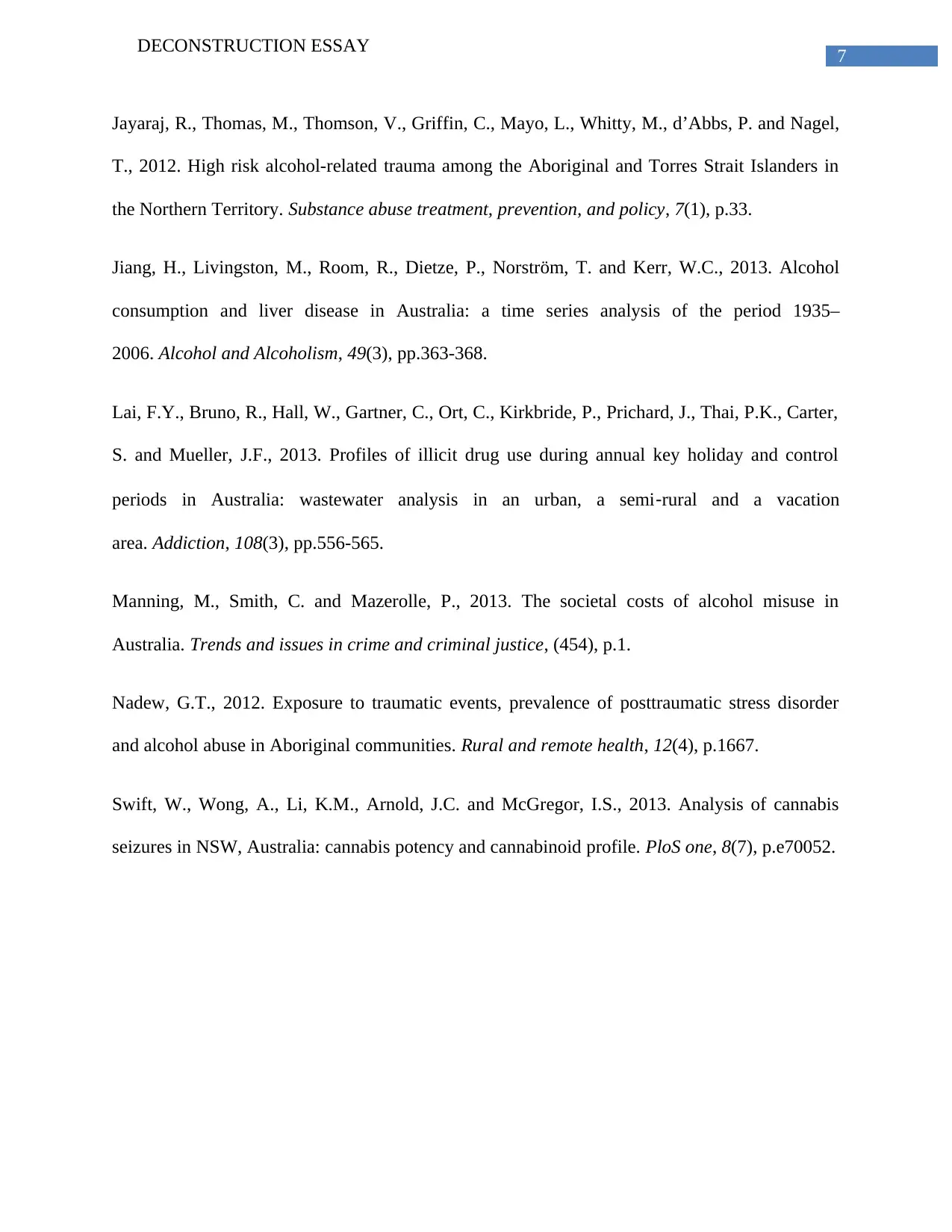
7
DECONSTRUCTION ESSAY
Jayaraj, R., Thomas, M., Thomson, V., Griffin, C., Mayo, L., Whitty, M., d’Abbs, P. and Nagel,
T., 2012. High risk alcohol-related trauma among the Aboriginal and Torres Strait Islanders in
the Northern Territory. Substance abuse treatment, prevention, and policy, 7(1), p.33.
Jiang, H., Livingston, M., Room, R., Dietze, P., Norström, T. and Kerr, W.C., 2013. Alcohol
consumption and liver disease in Australia: a time series analysis of the period 1935–
2006. Alcohol and Alcoholism, 49(3), pp.363-368.
Lai, F.Y., Bruno, R., Hall, W., Gartner, C., Ort, C., Kirkbride, P., Prichard, J., Thai, P.K., Carter,
S. and Mueller, J.F., 2013. Profiles of illicit drug use during annual key holiday and control
periods in Australia: wastewater analysis in an urban, a semi‐rural and a vacation
area. Addiction, 108(3), pp.556-565.
Manning, M., Smith, C. and Mazerolle, P., 2013. The societal costs of alcohol misuse in
Australia. Trends and issues in crime and criminal justice, (454), p.1.
Nadew, G.T., 2012. Exposure to traumatic events, prevalence of posttraumatic stress disorder
and alcohol abuse in Aboriginal communities. Rural and remote health, 12(4), p.1667.
Swift, W., Wong, A., Li, K.M., Arnold, J.C. and McGregor, I.S., 2013. Analysis of cannabis
seizures in NSW, Australia: cannabis potency and cannabinoid profile. PloS one, 8(7), p.e70052.
DECONSTRUCTION ESSAY
Jayaraj, R., Thomas, M., Thomson, V., Griffin, C., Mayo, L., Whitty, M., d’Abbs, P. and Nagel,
T., 2012. High risk alcohol-related trauma among the Aboriginal and Torres Strait Islanders in
the Northern Territory. Substance abuse treatment, prevention, and policy, 7(1), p.33.
Jiang, H., Livingston, M., Room, R., Dietze, P., Norström, T. and Kerr, W.C., 2013. Alcohol
consumption and liver disease in Australia: a time series analysis of the period 1935–
2006. Alcohol and Alcoholism, 49(3), pp.363-368.
Lai, F.Y., Bruno, R., Hall, W., Gartner, C., Ort, C., Kirkbride, P., Prichard, J., Thai, P.K., Carter,
S. and Mueller, J.F., 2013. Profiles of illicit drug use during annual key holiday and control
periods in Australia: wastewater analysis in an urban, a semi‐rural and a vacation
area. Addiction, 108(3), pp.556-565.
Manning, M., Smith, C. and Mazerolle, P., 2013. The societal costs of alcohol misuse in
Australia. Trends and issues in crime and criminal justice, (454), p.1.
Nadew, G.T., 2012. Exposure to traumatic events, prevalence of posttraumatic stress disorder
and alcohol abuse in Aboriginal communities. Rural and remote health, 12(4), p.1667.
Swift, W., Wong, A., Li, K.M., Arnold, J.C. and McGregor, I.S., 2013. Analysis of cannabis
seizures in NSW, Australia: cannabis potency and cannabinoid profile. PloS one, 8(7), p.e70052.
1 out of 8
Related Documents
Your All-in-One AI-Powered Toolkit for Academic Success.
+13062052269
info@desklib.com
Available 24*7 on WhatsApp / Email
![[object Object]](/_next/static/media/star-bottom.7253800d.svg)
Unlock your academic potential
Copyright © 2020–2025 A2Z Services. All Rights Reserved. Developed and managed by ZUCOL.




